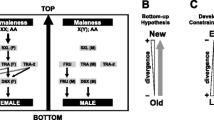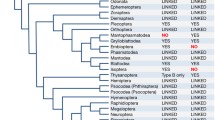Abstract
Sex-lethal (Sxl) functions as the switch gene for sex-determination in Drosophila melanogaster by engaging a regulatory cascade. Thus far the origin and evolution of both the regulatory system and SXL protein’s sex-determination function have remained largely unknown. In this study, we explore systematically the Sxl homologs in a wide range of insects, including the 12 sequenced Drosophila species, medfly, blowflies, housefly, Megaselia scalaris, mosquitoes, butterfly, beetle, honeybee, ant, and aphid. We find that both the male-specific and embryo-specific exons exist in all Drosophila species. The homologous male-specific exon is also present in Scaptodrosophila lebanonensis, but it does not have in-frame stop codons, suggesting the exon’s functional divergence between Drosophila and Scaptodrosophila after acquiring it in their common ancestor. Two motifs closely related to the exons’ functions, the SXL binding site poly(U) and the transcription-activating motif TAGteam, surprisingly exhibit broader phylogenetic distributions than the exons. Some previously unknown motifs that are restricted to or more abundant in Drosophila and S. lebanonensis than in other insects are also identified. Finally, phylogenetic analysis suggests that the SXL’s novel sex-determination function in Drosophila is more likely attributed to the changes in the N- and C-termini rather than in the RNA-binding region. Thus, our results provide a clearer picture of the phylogeny of the Sxl’s cis-regulatory elements and protein sequence changes, and so lead to a better understanding of the origin of sex-determination in Drosophila and also raise some new questions regarding the evolution of Sxl.








Similar content being viewed by others
Abbreviations
- CDS:
-
Coding sequence
- HMM:
-
Hidden Markov model
- AA:
-
Amino acid
- RRM:
-
RNA recognition motif
- RBD:
-
RNA-binding domain
References
Bailey TL, Elkan C (1994) Fitting a mixture model by expectation maximization to discover motifs in biopolymers. Proc Int Conf Intell Syst Mol Biol 2:28–36
Bailey TL, Boden M, Buske FA, Frith M, Grant CE, Clementi L, Ren J, Li WW, Noble WS (2009) MEME SUITE: tools for motif discovery and searching. Nucleic Acids Res 37:W202-208. doi:10.1093/nar/gkp335
Bell LR, Maine EM, Schedl P, Cline TW (1988) Sex-lethal, a Drosophila sex determination switch gene, exhibits sex-specific RNA splicing and sequence similarity to RNA binding proteins. Cell 55(6):1037–1046
Bopp D, Calhoun G, Horabin JI, Samuels M, Schedl P (1996) Sex-specific control of Sex-lethal is a conserved mechanism for sex determination in the genus Drosophila. Development 122(3):971–982
Cline TW, Dorsett M, Sun S, Harrison MM, Dines J, Sefton L, Megna L (2010) Evolution of the Drosophila feminizing switch gene Sex-lethal. Genetics 186(4):1321–1336. doi:10.12120210.1534/genetics.110.121202
Cook KB, Kazan H, Zuberi K, Morris Q, Hughes TR (2011) RBPDB: a database of RNA-binding specificities. Nucleic Acids Res 39:D301–D308. doi:10.1093/nar/gkq1069
Deshpande G, Calhoun G, Schedl PD (1999) The N-terminal domain of Sxl protein disrupts Sxl autoregulation in females and promotes female-specific splicing of tra in males. Development 126(13):2841–2853
Drysdale R (2008) FlyBase : a database for the Drosophila research community. Methods Mol Biol 420:45–59. doi:10.1007/978-1-59745-583-1_3
Flicek P, Amode MR, Barrell D, Beal K, Brent S, Carvalho-Silva D, Clapham P, Coates G, Fairley S, Fitzgerald S, Gil L, Gordon L, Hendrix M, Hourlier T, Johnson N, Kahari AK, Keefe D, Keenan S, Kinsella R, Komorowska M, Koscielny G, Kulesha E, Larsson P, Longden I, McLaren W, Muffato M, Overduin B, Pignatelli M, Pritchard B, Riat HS, Ritchie GR, Ruffier M, Schuster M, Sobral D, Tang YA, Taylor K, Trevanion S, Vandrovcova J, White S, Wilson M, Wilder SP, Aken BL, Birney E, Cunningham F, Dunham I, Durbin R, Fernandez-Suarez XM, Harrow J, Herrero J, Hubbard TJ, Parker A, Proctor G, Spudich G, Vogel J, Yates A, Zadissa A, Searle SM (2012) Ensembl 2012. Nucleic Acids Res 40:D84–D90. doi:10.1093/nar/gkr991
Handa N, Nureki O, Kurimoto K, Kim I, Sakamoto H, Shimura Y, Muto Y, Yokoyama S (1999) Structural basis for recognition of the tra mRNA precursor by the Sex-lethal protein. Nature 398(6728):579–585. doi:10.1038/19242
Horabin JI, Schedl P (1993a) Regulated splicing of the Drosophila Sex-lethal male exon involves a blockage mechanism. Mol Cell Biol 13(3):1408–1414
Horabin JI, Schedl P (1993b) Sex-lethal autoregulation requires multiple cis-acting elements upstream and downstream of the male exon and appears to depend largely on controlling the use of the male exon 5′ splice site. Mol Cell Biol 13(12):7734–7746
Kandul NP, Noor MA (2009) Large introns in relation to alternative splicing and gene evolution: a case study of Drosophila bruno-3. BMC Genet 10:67. doi:10.1186/1471-2156-10-67
Meise M, Hilfiker-Kleiner D, Dubendorfer A, Brunner C, Nothiger R, Bopp D (1998) Sex-lethal, the master sex-determining gene in Drosophila, is not sex-specifically regulated in Musca domestica. Development 125(8):1487–1494
Miyasaka H (1999) The positive relationship between codon usage bias and translation initiation AUG context in Saccharomyces cerevisiae. Yeast 15(8):633–637. doi:10.1002/(SICI)1097-0061(19990615)15:8<633:AID-YEA407>3.0.CO;2-O
Mount SM, Burks C, Hertz G, Stormo GD, White O, Fields C (1992) Splicing signals in Drosophila: intron size, information content, and consensus sequences. Nucleic Acids Res 20(16):4255–4262
Mullon C, Pomiankowski A, Reuter M (2012) Molecular evolution of Drosophila Sex-lethal and related sex determining genes. BMC Evol Biol 12:5. doi:10.1186/1471-2148-12-5
Penalva LO, Sanchez L (2003) RNA binding protein Sex-lethal (Sxl) and control of Drosophila sex determination and dosage compensation. Microbiol Mol Biol Rev 67(3):343–359
Penalva LO, Sakamoto H, Navarro-Sabate A, Sakashita E, Granadino B, Segarra C, Sanchez L (1996) Regulation of the gene Sex-lethal: a comparative analysis of Drosophila melanogaster and Drosophila subobscura. Genetics 144(4):1653–1664
Saccone G, Peluso I, Artiaco D, Giordano E, Bopp D, Polito LC (1998) The Ceratitis capitata homologue of the Drosophila sex-determining gene Sex-lethal is structurally conserved, but not sex-specifically regulated. Development 125(8):1495–1500
Salz HK (2011) Sex determination in insects: a binary decision based on alternative splicing. Curr Opin Genet Dev 21(4):395–400. doi:10.1016/j.gde.2011.03.001
Salz HK, Maine EM, Keyes LN, Samuels ME, Cline TW, Schedl P (1989) The Drosophila female-specific sex-determination gene, Sex-lethal, has stage-, tissue-, and sex-specific RNAs suggesting multiple modes of regulation. Genes Dev 3(5):708–719
Satija R, Bradley RK (2012) The TAGteam motif facilitates binding of 21 sequence-specific transcription factors in the Drosophila embryo. Genome Res 22(4):656–665. doi:10.1101/gr.130682.111
Sievert V, Kuhn S, Paululat A, Traut W (2000) Sequence conservation and expression of the Sex-lethal homologue in the fly Megaselia scalaris. Genome 43(2):382–390
Sorek R (2007) The birth of new exons: mechanisms and evolutionary consequences. RNA 13(10):1603–1608. doi:10.1261/rna.682507
Sussman JL, Lin D, Jiang J, Manning NO, Prilusky J, Ritter O, Abola EE (1998) Protein Data Bank (PDB): database of three-dimensional structural information of biological macromolecules. Acta Crystallogr D 54(Pt 6 Pt 1):1078–1084
Tamura K, Peterson D, Peterson N, Stecher G, Nei M, Kumar S (2011) MEGA5: molecular evolutionary genetics analysis using maximum likelihood, evolutionary distance, and maximum parsimony methods. Mol Biol Evol 28(10):2731–2739. doi:10.1093/molbev/msr121
ten Bosch JR, Benavides JA, Cline TW (2006) The TAGteam DNA motif controls the timing of Drosophila pre-blastoderm transcription. Development 133(10):1967–1977. doi:10.1242/dev.02373
Thompson JD, Gibson TJ, Higgins DG (2002) Multiple sequence alignment using ClustalW and ClustalX. Curr Protoc Bioinformatics Chapter 2, Unit 2.3. doi:10.1002/0471250953.bi0203s00
Traut W, Niimi T, Ikeo K, Sahara K (2006) Phylogeny of the sex-determining gene Sex-lethal in insects. Genome 49(3):254–262. doi:10.1139/g05-107
UniProt Consortium (2012) Reorganizing the protein space at the Universal Protein Resource (UniProt). Nucleic Acids Res 40:D71–D75. doi:10.1093/nar/gkr981
Waterhouse AM, Procter JB, Martin DM, Clamp M, Barton GJ (2009) Jalview Version 2—a multiple sequence alignment editor and analysis workbench. Bioinformatics 25(9):1189–1191. doi:10.1093/bioinformatics/btp033
Yang Z (2007) PAML 4: phylogenetic analysis by maximum likelihood. Mol Biol Evol 24(8):1586–1591. doi:10.1093/molbev/msm088
Yang D, Lu H, Hong Y, Jinks TM, Estes PA, Erickson JW (2001) Interpretation of X chromosome dose at Sex-lethal requires non-E-box sites for the basic helix-loophelix proteins SISB and daughterless. Mol Cell Biol 21(5):1581–1592. doi:10.1128/MCB.21.5.1581-1592.2001
Yanowitz JL, Deshpande G, Calhoun G, Schedl PD (1999) An N-terminal truncation uncouples the sex-transforming and dosage compensation functions of Sex-lethal. Mol Cell Biol 19(4):3018–3028
Acknowledgments
We thank Prof. Thomas Cline for sending us the genomic sequences near the male-specific exon and Dr. Hielim Kim for comments on the early version of the manuscript. We thank Prof. Claude dePamphilis and his lab members for useful comments on our work. We thank Dr. Alfred M. Handler at the USDA-ARS for sending us the link of the medfly genomic sequence.
Conflict of interest
The authors declare that they have no conflict of interest.
Author information
Authors and Affiliations
Corresponding author
Electronic supplementary material
Below is the link to the electronic supplementary material.
Rights and permissions
About this article
Cite this article
Zhang, Z., Klein, J. & Nei, M. Evolution of the Sex-lethal Gene in Insects and Origin of the Sex-Determination System in Drosophila . J Mol Evol 78, 50–65 (2014). https://doi.org/10.1007/s00239-013-9599-3
Received:
Accepted:
Published:
Issue Date:
DOI: https://doi.org/10.1007/s00239-013-9599-3




